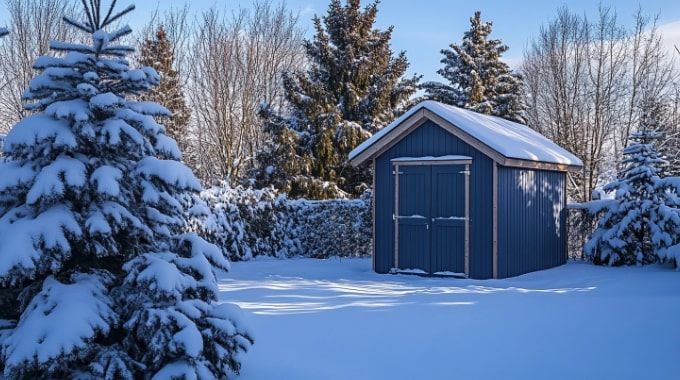
How to properly insulate a shed for four-season use?
Imagine: the wind is blowing, the snow is falling in large flakes, but you, warm in your shed, can indulge in your passions, whether it be DIY, reading or even a quiet little office far from the hustle and bustle of the house.
A shed that can be used all year round is a real asset, a versatile space that adapts to your needs, whatever the season. But to take full advantage of this space in winter as in summer, adequate insulation is essential.
In Quebec, with our harsh winters and our sometimes hot and humid summers, insulating your shed for four-season use is not a luxury, it is a necessity.
Good insulation will not only allow you to maintain a comfortable temperature inside, but also reduce your heating and cooling costs, while protecting the structure of your shed against damage caused by humidity and temperature variations. So, ready to transform your shed into a true haven of peace that can be used all year round? We'll explain everything to you!
Do you think that insulating a shed is just for the winter? Think again!
Of course, the first thing that comes to mind when we talk about insulation is comfort during the cold months. No one wants to shiver in their shed in the middle of winter! Good insulation helps retain heat inside, creating a warm and pleasant space even when the mercury drops outside.
But insulation isn't just about warmth in winter. It's also a question of comfort in summer. A well-insulated shed will prevent excessive heat from the sun from penetrating inside, keeping the space cool and pleasant even on the hottest days. Imagine being able to take refuge in your shed to escape the heatwave!
Additionally, adequate insulation plays a crucial role in moisture management. In Quebec, humidity can be a significant problem, especially during the summer months.
Good insulation, combined with proper ventilation, will help prevent condensation and moisture buildup inside your shed's walls and roof, which could lead to mold problems and structural deterioration in the long term.
According to Natural Resources Canada, a home (and by extension, a well-insulated shed) can significantly reduce its heating and cooling needs, resulting in energy savings and a reduced environmental footprint. Investing in good insulation for your shed is therefore a wise choice on several levels.
So, you see, insulating a shed for four-season use is much more than just protecting yourself from the cold in winter. It is a complete solution for optimal comfort all year round, better humidity management and energy savings. In the next section, we will explore the different types of insulation available to you for your project.
Mineral wool, cellulose, polyurethane... What is the best insulation for your shed in Quebec? The big comparison.
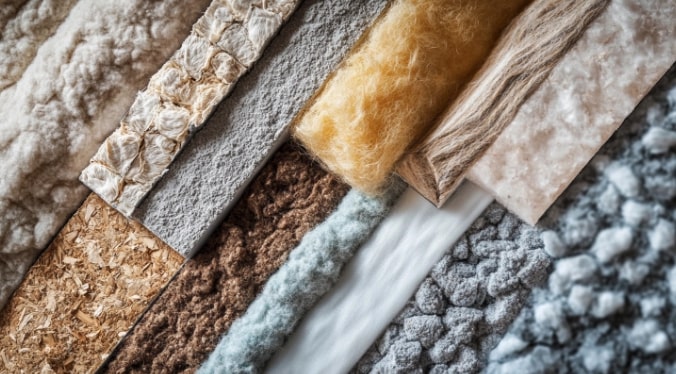
The market offers a variety of insulating materials, each with its own characteristics, advantages and disadvantages. Making the right choice will depend on your budget, your personal preferences and the specifics of your shed. Here is an overview of the most common options in Quebec:
- Mineral wool (fiberglass or rock wool): It is one of the most popular and affordable insulators. It offers good thermal performance and is fire resistant. Rock wool is generally denser and offers better sound insulation than fiberglass. However, mineral wool can be sensitive to humidity and requires careful handling (wearing gloves, mask, glasses).
- Blown cellulose: Made from recycled newspaper, cellulose is an environmentally friendly and economical choice. It offers good thermal performance and excellent fire resistance thanks to flame-retardant treatments. It is particularly effective for insulating walls and roofs with irregular cavities. Installation usually requires specialized equipment.
- Polyurethane (sprayed or in rigid panels): Spray polyurethane offers excellent thermal performance and creates a tight air barrier, which is very advantageous in preventing air and moisture infiltration. It is ideal for hard to reach places. However, it is frequently more expensive than other options and must be installed by professionals. Rigid polyurethane panels also offer good thermal performance and are easier to handle for self-installation, but the joints must be well sealed.
- Polystyrene (extruded or expanded): Polystyrene is a lightweight, moisture-resistant insulation. Extruded polystyrene (XPS) is denser and offers better thermal performance than expanded polystyrene (EPS). It is often used to insulate foundations and floors, but can also be used for walls and roofs. It is relatively simple to cut and install.
- Sheep wool: It is a natural and ecological option that offers good thermal and acoustic insulation. It is also resistant to humidity and mold. However, it is generally more expensive than other options.
According to a study by the Quebec Association for Renewable Energy Production (AQPER), the choice of insulation can have a significant impact on the overall energy performance of a building. It is therefore important to learn about the properties of each material before making a decision.
Choosing the best insulation for your shed will depend on several factors, including your budget, the climate of your region (although generally similar to Quebec), the configuration of your shed and your objectives in terms of energy performance and comfort.
In the following sections, we will explore in more detail how to insulate the different parts of your shed for four-season use.
Insulating the walls of your shed: the key step for optimal comfort.
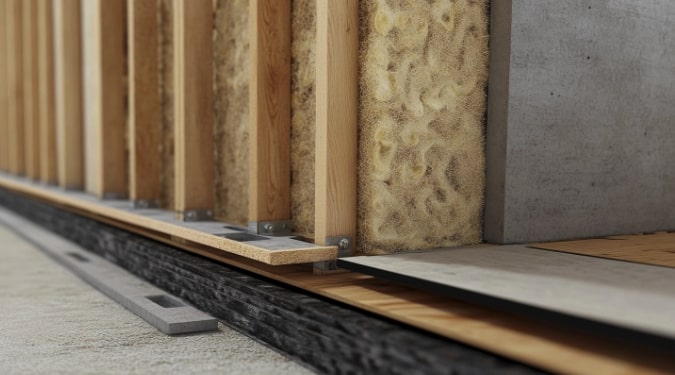
Walls represent a large surface area through which heat can escape in winter and penetrate in summer. Adequate wall insulation is therefore essential to ensure the comfort of your 4-season shed.
The method of insulating the walls will depend on the structure of your shed. If the walls are constructed with studs (like a wood frame house), insulation can be installed between these studs. Mineral wool (in rolls or panels) is a common and relatively easy option to install in this type of structure.
Simply cut the pieces of insulation to size and insert them between the studs. It is important to ensure that the insulation fills the space well without being too compressed.
Blown cellulose can also be used to insulate walls with cavities. It is injected under pressure into the spaces between the uprights, creating a uniform insulating layer without thermal bridges. This method is often used during construction or renovation.
The rigid polyurethane or polystyrene panels can be attached directly to the wall studs, either inside or outside the shed. They offer good thermal performance and can also serve as a vapor barrier if the joints are well sealed.
A crucial step when insulating walls is installing a vapor barrier on the warm side (usually the inside of the shed). The vapor barrier prevents moisture from the interior air from penetrating the walls and condensing, which could lead to mold problems and deterioration of the insulation and structure.
A 6 mm thick polyethylene film is commonly used as a vapor barrier. It must be installed continuously, sealing the joints and the edges of the openings (doors and windows) well with appropriate adhesive tape.
According to the Quebec Housing Corporation (SHQ), good wall insulation can significantly reduce heat loss in winter. The thickness of the insulation to use will depend on the climate of your region and the level of energy performance you wish to achieve.
The recommended R values for walls in Quebec usually vary between R-20 and R-24 for residential use. Although your shed is not a primary residence, aiming for similar values can be wise for optimal four-season comfort.
Don't forget to also insulate the junctions between the walls and the foundation, as well as around openings, to minimize thermal bridges. Quality caulking can make a big difference.
The roof: a crucial area to insulate to prevent heat loss and overheating.
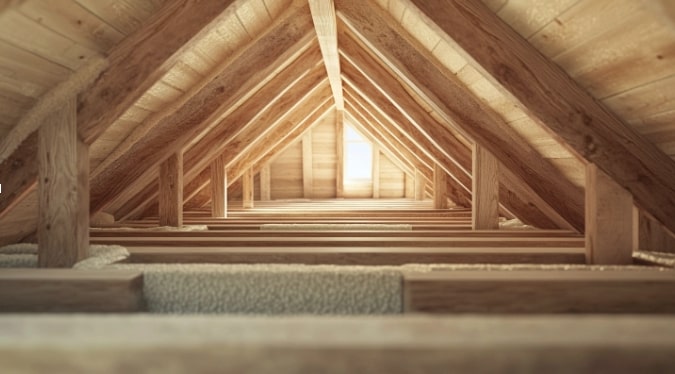
The roof is another area through which a significant amount of heat can escape in winter (hot air rises) and enter in summer. Adequate insulation of the roof is therefore just as important as that of the walls for a 4-season shed.
Roof insulation methods are similar to those used for walls. If your shed has a roof with rafters, insulation (mineral wool in rolls or panels) can be installed between these rafters. Once again, make sure the insulation fills the space well and that a vapor barrier is installed on the interior side.
For flat roofs or with a slight slope, rigid insulation panels (polyurethane or polystyrene) are often a good option. They can be installed above the roof deck before the waterproofing membrane is installed.
Blown cellulose can also be used to insulate roofs with hollow spaces, such as cathedral roofs.
It is crucial to ensure good ventilation of the attic (if there is one) to avoid the accumulation of humidity and the formation of ice in winter, as well as overheating in summer. Soffits and roof vents can be installed to allow adequate air circulation.
According to the Office of Energy Efficiency, up to 25% of a home's heat loss can occur through the roof. Although your shed is smaller, the proportion can be similar if the roof is not well insulated. Aiming for a higher R-value for the roof than for the walls is generally recommended, often between R-30 and R-40 for a climate like ours.
Also think about insulating the ceiling if your shed has an attic. Insulating the ceiling is an effective way to retain heat in the living space.
Don't forget the floor! Insulate the base for floor-to-ceiling comfort.
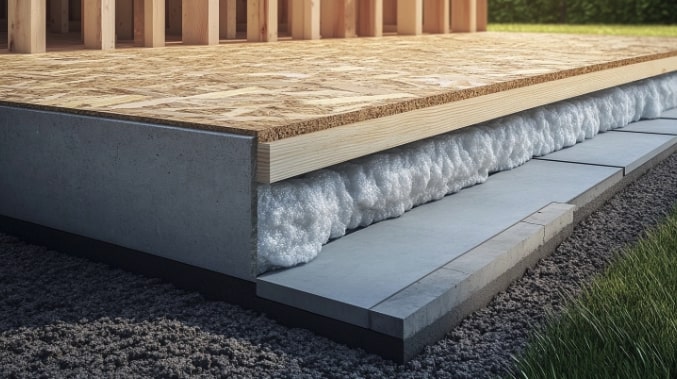
Generally neglected, floor insulation is nevertheless essential for optimal comfort in your four-season shed, especially if the shed is not installed on an insulated concrete slab. A cold floor can make the space uncomfortable, even if the walls and roof are well insulated.
If your shed rests on stilts or concrete blocks, insulation can be installed between the floor joists. Mineral wool in rolls, supported by nets or pins, is a common option. Rigid insulation boards can also be cut and inserted between the joists.
If your shed is installed on a concrete slab, you can insulate the slab itself during construction by placing rigid insulation panels under the slab or on top before pouring a screed. If the shed is already built on an uninsulated slab, you can add a layer of rigid insulation on top and cover everything with a floating floor or other covering.
Installing a vapor barrier under the floor insulation (especially if the shed is on stilts or blocks) is important to prevent ground moisture from rising and affecting the insulation.
According to a study by the CMHC (Canadian Mortgage Corporation)es and housing), floor insulation, especially above an unheated space such as a crawl space or the exterior, can significantly improve thermal comfort and reduce heat loss. Aiming for an R-value of at least R-20 for the floor is a good practice.
Heating and ventilation: the allies of a comfortable and healthy 4-season shed.
Even with excellent insulation, a heating system will be necessary to maintain a comfortable temperature in your shed during the cold months. Several options are available to you:
- Electric radiators: They are easy to install and relatively affordable to purchase. Different models are available, such as baseboard heaters, convectors or inertia radiators. Choose a model adapted to the size of your shed.
- Propane heaters: They provide powerful, rapid heating, but require proper installation and ventilation for safety reasons.
- Heat pumps: They can heat in winter and cool in summer, offering a versatile and potentially more energy-efficient solution in the long term.
It is crucial to choose a heating system adapted to the size of your shed and to follow the manufacturer's safety instructions during installation and use.
Ventilation is just as important as heating and insulation for a comfortable and healthy 4-season shed. Good ventilation allows stale air and humidity to escape and fresh air to be introduced. Several options are possible:
- Natural ventilation: Well-placed windows and vents can create natural air circulation.
- Mechanical ventilation: An exhaust fan installed in the upper part of the shed can help exhaust humid air. For more efficient ventilation, a ventilation system with heat recovery (HRV) can be considered, especially if the shed is used frequently.
According to the APCHQ, good ventilation is essential to maintain good indoor air quality and prevent humidity problems.
Doors and windows: weak points not to be neglected for effective insulation.
Doors and windows can be weak points in the insulating envelope of your shed if they are not well chosen and installed. Opt for doors and windows designed for good energy performance, with insulating frames and double or triple glazing.
Make sure doors and windows are well sealed to prevent air infiltration. Quality caulking around frames can make a big difference. Also consider the orientation of your shed when planning to maximize passive solar heat gain in winter and minimize overheating in summer.
An insulated shed is an investment in comfort and pleasure, all year round!
Caba
Insulating your shed for four-season use is a worthwhile investment if you want to enjoy this space all year round. By choosing the right materials, following best installation practices and not forgetting ventilation and heating, you can transform your shed into a comfortable, warm and pleasant space, whatever the outside temperature.
At the house of Boyer sheds, we are here to help you carry out your 4-season shed project. Our team can advise you on the best insulation options for our different models and answer all your questions. Do not hesitate to visit our website to discover our range of sheds and to contact us to discuss your specific needs. Together, let's create the outdoor space of your dreams, usable in all seasons!
Questions and Answers (Q/A)
Q: What is the best type of insulation for a four-season shed in Quebec? R : There is no universal “best” insulator. The choice depends on your budget, the configuration of your shed and your preferences. Mineral wool, cellulose and polyurethane are all good options to consider.
Q: Should I install a vapor barrier when insulating my shed? R : Yes, installing a vapor barrier on the warm side of the insulation is essential to prevent moisture from penetrating the walls and roof and causing problems.
Q: What R-value should I aim for insulating my four-season shed? R : For a climate like that of Quebec, aiming for an R value of at least R-20 for the walls and floor, and R-30 for the roof is a good practice for four-season comfort.
Q: Is ventilation important in an insulated shed? R : Yes, good ventilation is crucial to wick away moisture and maintain good indoor air quality in an insulated shed.
Q: Does Cabanons Boyer offer insulated shed options? R : Yes, at Cabanons Boyer, we can advise you and offer you solutions to insulate your shed according to your needs for 4-season use. Contact us to find out more!